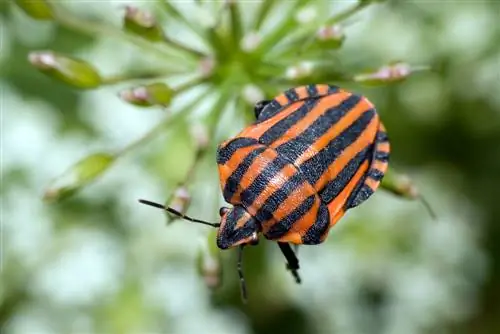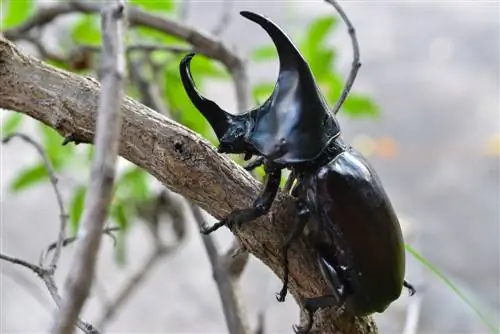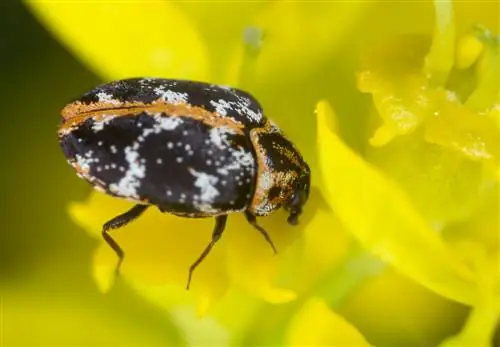- Author admin [email protected].
- Public 2023-12-16 16:46.
- Last modified 2025-06-01 06:02.
The question has been around since the knight bug was named insect of the year in 2007. This magnificent, red and black insect must be a beetle - or not? This guide sheds light on five important differences. Immerse yourself in the colorful diversity of local bugs and learn to accurately identify the overlooked natural beauties.
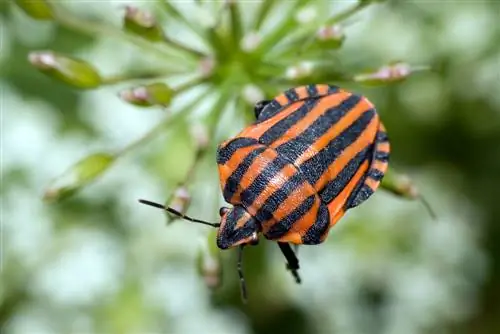
What are the differences between bedbugs and beetles?
Bugs and beetles are different groups of insects: Bugs have a proboscis, wings and scent glands, feed only on liquids and produce nymphs. Beetles, on the other hand, have biting and chewing tools, armored cover wings, consume solid and liquid food, do not smell and produce larvae as offspring.
- Bedbugs are not beetles.
- Bugs have proboscis, wings, scent glands, feed exclusively on liquids and produce nymphs as offspring.
- Beetles have biting and chewing tools, armored wings, eat solid and liquid food, do not smell and produce larvae as offspring.
Bedbugs are not beetles - 5 differences
One look at the table below is enough and you will never lump bedbugs and beetles together again. According to a common classification as insects (Insecta), subclass flying insects (Pterygota), the paths of the two hexapods already separate into bugs (Heteroptera) and beetles (Coleoptera). This botanical categorization is reflected in 5 significant differences that cannot go unnoticed even by an insect layman.
| Differences | Bugs | Beetle |
|---|---|---|
| Mouthparts | Proboscis | Biting and chewing tools |
| flying machine | Wings | Tanks cover wings |
| scent glands | yes | no |
| Food | liquid | solid and liquid |
| Descendants | Nymphs | Larvae |
Please note that this table does not claim to be scientifically relevant. There are numerous exceptions to the rule among the more than 40,000 species of bedbugs and 360,000 species of beetles on our planet. The aim of this table is to provide an informative overview for insect amateurs of the outstanding differences between bugs and beetles.
Distinctive feature mouthpart
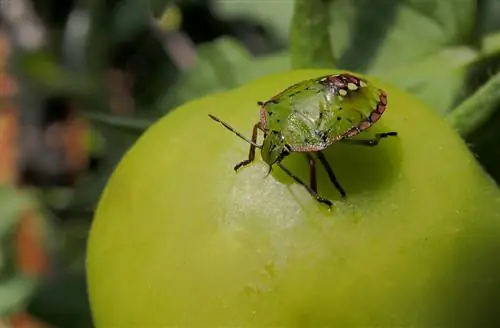
Bedbugs have a proboscis through which they get their food
Bedbugs have a proboscis. The so-called rostrum consists of two thin tubes and is usually folded under the body. The proboscis extends to take in food. The bug injects a digestive juice into its food through one tube. The food decomposes and is sucked up through the second tube.
Beetles use biting and chewing tools to eat.
Flying machine makes the difference
The main difference between bedbugs and beetles is the flying apparatus. The beetle's wing structure consists of two pairs of wings. The solid, armor-like or soft cover wings protect a delicate, transparent pair of wings. The skin wings are only visible when the beetles are flying. In flightless beetles, the hardened cover wings are often fused together, as in most ground beetles or some weevils.
In contrast, the wings of bugs are always visible and are composed of two parts. The forewings are soft at the back and slightly horny at the front and are therefore called half-coverts. Bugs can unfold their soft hind wings in a fan shape.
Telltale scent glands
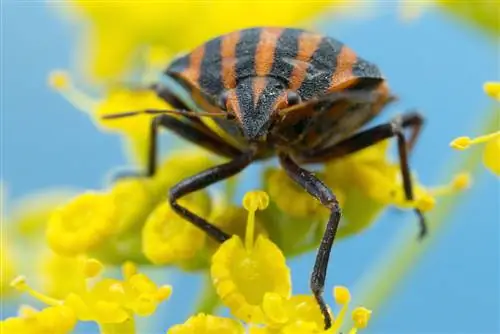
Bedbugs communicate and pass through scent glands
Bedbugs have a special smell. The built-in scent glands fulfill several tasks. If there is danger, the attacker will receive a defensive secretion that can smell bad. Numerous bugs exude a fruity scent in order to communicate with other species.
Food intake criterion
The structure of their mouthparts already suggests this. Bedbugs only eat liquid food. Beetles also eat solid food. Many species of bugs eat plant juices, often the nutritious liquid of ripe seeds. Only the dreaded bed bugs feed on blood. The diet of beetles is much more variable. The spectrum extends from herbaceous plants to wood, leather and food to carrion and live insects.
Different offspring
Little nymphs hatch from bug eggs. With each molt, the mini bugs become more similar to their parents. In contrast, beetle offspring undergo a complete change, called metamorphosis. Tiny larvae hatch from the eggs, which do not allow any conclusions to be drawn about the type of beetle parents. Only after pupation does a finished beetle emerge from the shell.
Excursus
Bugs ugh? - because of vermin
Bedbugs are insects with a terribly bad reputation. Bed bugs (Cimex lectularius) are responsible for this. Introduced into the house, the blood-sucking beasts make life hell for their human victim in bed. We have thus named the only pest among more than 40,000 species of bugs. The vast majority of native bugs prefer to slurp plant sap, suck on fungal spores or dead insects. It's high time to straighten out the crooked picture and get bugs out of the vermin corner.
Determine native bugs with a beetle look
Several local bugs lead the layman on the wrong track and come in beetle outfits. Leading the way as beetle doppelgangers in Germany are five species of bugs that have either always been native or were introduced. The following table shows which features you can use to reliably identify bedbugs:
| Bugs in beetle look | Firebug | Stripe bug | Marbled Stink Bug | Green Stink Bug | American Bug Beetles |
|---|---|---|---|---|---|
| Size | 6-12mm | 8-12mm | 12-17 mm | 10-14 mm | 16-21mm |
| color | fire red | red | ocher marbled | green | brown |
| Color legs | black | black | ocher to brown | greenish-brown | brown |
| Body shape | oval | flat, roundish | flat, leaf-shaped | wide-oval | oblong-oval |
| Special feature | black pattern | red-black stripes | long, white ringed antennae | dark spotted abdomen | white zigzag drawing |
| Botanical name | Pyrrhocoris apterus | Graphosoma lineatum | Halyomorpha halys | Palomena prasina | Leptoglossus occidentalis |
| Middle name | Firebugs | Striped Beetle | Stink bug, stink beetle | Common Greenling | American cone bug |
| Family | Firebugs | Stunk Bugs | Stunk Bugs | Stunk Bugs | Border bugs |
The following short portraits provide in-depth information for an expert identification of these beetle-like bugs.
Fire bug (Pyrrhocoris apterus)
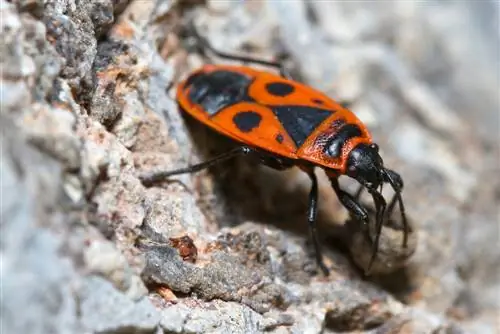
The fire bug is often mistaken for a beetle
Fire bugs are the insects most commonly confused with beetles. For good reason. The flat, oval, red body is decorated with an artistic, black pattern. Six black legs are used for locomotion because fire beetles cannot fly. It is characterized by a trapezoidal, bright red pronotum with an angular, black blemish in the middle. When a fire bug falls on its pretty back, it reveals a black underside with no notable features. By the way, the fire bug looks deceptively similar to its famous counterpart, the knight bug (Lygaeus equestris). The latter can be distinguished by white spots on the red-black patterned body.
- When to find: April to September
- Where to find: under trees and mallow plants of all kinds
The video below invites you to take a journey through the fascinating life of fire bugs.

Striped bug (Graphosoma lineatum)
A prime example of a bug that looks like a beetle is the striped bug. Six black longitudinal stripes adorn the red or orange-red upper surface. There are several black dots on the underside of the red body. If you get too close to harmless stripe bugs, the insects release a defensive secretion that smells like apples.
- When to find: April to September/October
- Where to find: in the garden in sunny locations with umbelliferous plants
Marbled stink bug (Halyomorpha halys)
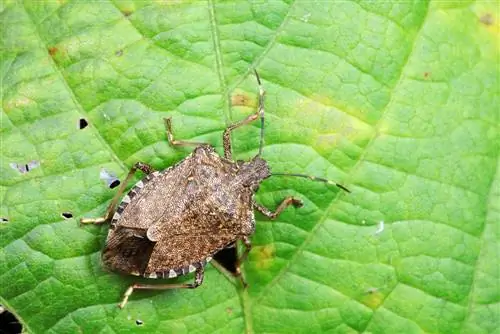
The marmorated stink bug is pretty to look at, but be careful: its scent secretion is tough!
The marmorated stink bug is easy to identify by an opaque part of the elytra with dark to ocher marbling and ringed, long antennae. Black lines can be seen on the transparent part of the hind wings. There are bright, yellowish to orange calluses on the shield between the wings and often also on the pronotum.
- When to find: March to November
- Where to find: in the garden, in the forest, in the apartment
Tip
In late summer, marmorated stink bugs enter buildings in search of winter quarters. There is a state of emergency in the apartment because the stink bugs live up to their name. With the glass trick you can maneuver uninvited guests out without releasing smelly secretions. Simply put a glass over the insects, put a piece of paper under it, take it outside and release it.
Green stink bug (Palomena prasina)
At first glance, the green stink bug looks confusingly similar to a green beetle, like the green shield beetle. A dark spot on the abdomen is helpful for a well-founded identification. Furthermore, a very delicate dotting on the grass-green, non-shiny body reveals that you are looking at a common greenling. When temperatures drop in autumn, the bugs turn brown for a few months for better camouflage.
- When to find: May to November
- Where to find: in deciduous trees, orchards, on the edge of the forest
American bug beetles (Leptoglossus occidentalis)
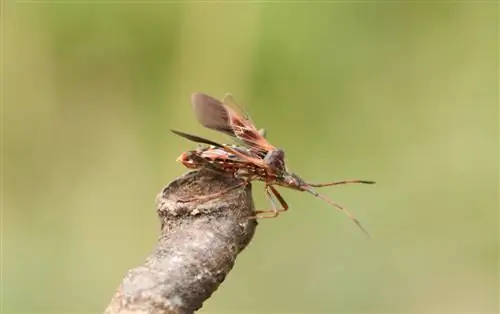
The American bug beetle can fly excellently
American bedbugs have been on the rise in Germany since 2006. The noticeably large bugs are significantly longer (16-21 mm) than they are wide (5-7 mm). What catches the eye are very long antennae and hind legs with a distinctive, leaf-like extension. The bed bugs can fly excellently. When the wings are open, a yellow-orange abdomen pattern can be admired. The reddish-brown wing coverts are decorated with a narrow, white zigzag pattern.
- When to find: all year round
- Where to find: in the garden on conifers (summer), in the house, in the attic (winter)
Frequently asked questions
Can all bugs and beetles fly?
No, the ability to fly is not a clear distinguishing feature between bugs and beetles. In both insect categories there are flightless and flightless specimens. The beetle-like fire bugs cannot fly, but most stink bugs are real flying acrobats. Many weevils prefer to stay on the ground. Of course, this does not prevent the dreaded bark beetles as a subfamily from extensive swarm flights during the mating season.
Are there beetles that look like bedbugs?
There is a risk of confusion in both directions between bedbugs and beetles. A comprehensible example is the 10 mm small green shield beetle (Cassida viridis) from the leaf beetle family and the equally large green stink bug (Palomena prasina) from the stink bug family. Both insects are green, broadly oval and prefer to live on deciduous trees.
Tip
Predator bugs make short work of aphids, spider mites, thrips and whiteflies. The predatory bugs are so successful in biological pest control that they are specifically bred for sale. 100 predatory bugs are required per 50 square meters of infested area to destroy a pest in the garden, greenhouse, winter garden or house. The bug squad is delivered as live insects in an organic container with special carrier material and is positioned at the site of operation on the day of arrival.

